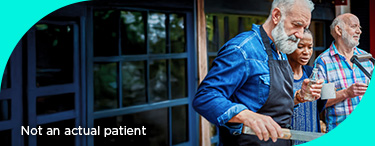Understanding
Partial-Onset
Seizures
Get the facts about partial-onset seizures
Education can be empowering. If you care for someone living with partial-onset seizures, you want to know all that you can about the condition, what to expect, and what someone with partial-onset seizures may experience. Getting the facts means that you'll be better equipped to help.
What are partial-onset seizures?
Partial seizures occur when abnormal electrical activity begins in only one part of the brain.
Partial-onset seizures include:
- Simple partial seizures, where a person remains fully aware and does not lose consciousness. He/she may experience muscle jerking or stiffening, or sense things that are not actually present.
- Complex partial seizures, where a person loses awareness, stares blankly, or may seem to be daydreaming. He/she may pick at their clothing or repeat words or phrases.
Share the facts about partial-onset seizures
One of the challenges facing those with epilepsy is the public's lack of knowledge about the condition. Misconceptions based on historical perceptions, lack of public awareness, and inaccurate television and movie portrayals lead to incorrect assumptions about epilepsy. Sometimes these create the misguided perception that those with epilepsy are mentally disabled or are more likely to be violent. Sometimes the forms seizures take can be mistaken to be deliberate acts, but they are not.
As a group, people with epilepsy have the same range of intelligence as the general public. As in any segment of the population, people with epilepsy have varying intellectual abilities.
Through public awareness and education, attitudes towards the condition are slowly changing. While it may not be necessary to discuss a person's epilepsy with everyone, thought should be given as to who should be told. The decision may depend partially on:
- The type and frequency of the seizures
- How close the relationship is
- Whether or not the person with epilepsy is likely to have a seizure in the person's company.
Caregivers can also help build a support system for the individual within his or her community that involves family, friends, neighbors, and professionals.
By learning about epilepsy and by sharing that information with others, caregivers can both help people to better understand the condition and increase awareness on how to assist a person who is having a seizure.
It has become accepted knowledge that many brilliant historical figures had epilepsy, including Vincent van Gogh, Fyodor Dostoevsky, and Isaac Newton.
A CAREGIVER'S GUIDE
This guide can help you collect useful information to share with your loved one's neurologist or epileptologist.
As a caregiver, you're in the unique position of being able to observe what your loved one is experiencing. The information below can help you identify what you should be looking for, and the patterns you should be noting and communicating to your loved one's healthcare team. Consider writing down what you observe in a journal that you can share with your loved one's healthcare team.
- Is there a pattern to your loved one's recent seizures? (Think of any changes in the number of seizures, how long they last, or what the seizures look like. Bring a video if possible).
- What event or activity was your loved one involved in before the seizure? (Triggers can include lack of sleep, stress, nutrition, flashing lights or use of alcohol).
- Did your loved one take their medication as prescribed before the seizure?
- Are the current antiseizure medicines your loved one is taking helping to control the partial-onset seizures? Tell the doctor the number and types of seizures your loved one is still having.
- Is your loved one having possible side effects from their current antiseizure medicine(s)? Tell the doctor which side effects interfere with daily activities, or which are the most difficult to cope with.
- Do you want to learn more about other antiseizure medicines?
- Do you have any questions since your last visit?
The content above was adapted from Epilepsy: A Guide for Professionals and Caregivers, © Edmonton Epilepsy Association, 2011. Edmonton, Alberta, Canada.

